Implementing the NSW Syllabus Change
On 8th December 2022, the new Mathematics K-10 Syllabus was published on the NSW Curriculum Website. (NESA, 2022)
We’re here to support you in implementing the new curriculum with ease. Below you will find what you need to know, how it affects your classroom and planning and how you can bring the moving parts together.
What do we need to get ready?
Part 1. What You Need to Know
New requirements for planning topics
A major change - we now have more flexibility!
The new 3-10 syllabuses will be taught in schools in NSW schools from 2024. (NESA, 2023) but schools can plan and prepare to teach the new 3-10 syllabuses in 2023. (NESA, 2023)
NESA, 2023 states:
- The Syllabus structure “provides flexibility for teachers in planning teaching and learning programs based on the needs and abilities of students.”
- “The structure is intended to extend students as far along the continuum of learning as possible and provide solid foundations for the highest levels of student achievement. The structure allows for a diverse range of endpoints” for students.
Maths Pathway gives you even more flexibility!
With Maths Pathway you can run both the old and new syllabus with different classes, giving you the flexibility you need throughout the transition.
So we’re free to teach students what they need the most!
We no longer need to tick off every box for every student, but instead can focus on what each individual needs the most – even across multiple stages.
From NESA, 2023:
- “Teachers can choose which content…to address, based on students’ prior learning, needs and abilities.”
- “It is acknowledged that students learn at different rates and in different ways. There may be students who will not demonstrate achievement in relation to one or more of the outcomes for the Stage.”
- “Teachers will need to address outcomes across different stages in order to meet the learning needs of students.”
- Teachers are expected to judge “when students need to work at, above or below stage level in relation to one or more of the outcomes. This recognises that outcomes may be achieved by students at different times across stages.”
But there’s a catch: we must now demonstrate that students’ needs are being identified and met. This requires two things:
First, that data is gathered on students’ needs: “Teachers use formative and summative assessment to determine instructional priorities and the time needed for students to achieve expected outcomes.” (NESA, 2023). Research tells us to expect a 6-8 year spread of attainment in a given class (Grattan Institute, 2015).
Second, that instruction is adapted using that data, adapting differently for different students.
Here are some concrete examples from NESA, 2023:
- A student “could be working on Stage 1 content in the Number and Algebra strand, while working on Early Stage 1 content in the Measurement and Geometry strand.”
- “In Stage 2 or Stage 3, some students may not have developed a complete understanding of place value and the role of zero to read, write and order two-digit and three-digit numbers. These students will need to access content from Early Stage 1 or Stage 1 before engaging with Stage 2 content in applying place value to larger numbers and decimals.”
- “In Stage 4 some students may not have developed a complete understanding of fractions, decimals and percentages and will need to access related outcomes from Stage 3.”
At Maths Pathway we have a team of maths teachers and mathematicians, writing content that not only maps to the NSW curriculum but pulls from contemporary research in mathematics education and is rigorously tested, using a data-driven approach.
Part 2. Planning Topics
How will it affect my classroom?
So how do we plan a topic now?
The key is to select a focus for the topic, telling us the content to focus on – but bake in adaptability in the learning and teaching approach for that content.
Select the focus:
In the new Syllabus, a Topic has one or more “Focus Areas”. Each Focus Area provides a specific list of Content to target as part of a Stage, along with Outcome(s). Selecting Topics and their Focus Areas for a given course’s Scope and Sequence is discussed below.
Bake in adaptability:
Create and document a plan which allows all students to grow along a continuum, using the Topic’s Content as a focus. Students should all move closer to meeting those Outcomes, and go beyond if possible. This includes:
- Relevant resources ready to go which span multiple stages to meet all students’ needs;
- A specific plan for how data will be gathered to pinpoint student needs; and
- A practical approach for deploying those resources to meet those pinpointed needs.
Want an example of a topic in full?
Download a free sample Topic Plan: Earning & Making Money
We’ve put everything Maths Teachers and School Leaders need to know about the updates to the NSW Syllabus in one place. We’ll be keeping it updated so you’re getting the right information.
Part 3. New Requirements for Scope & Sequence
Program builder update
Q: What about Program Builder?
This tool was available to teachers in NSW Schools to help create Scope and Sequence Documentation. Is it being updated for the new Syllabus? Should I wait for an update before I start planning?
A: Better not to wait – start planning anyway.
It’s not clear when or if an update will be available. The Program Builder website states “Program Builder will not support any new syllabuses.” This may refer only to the English K-2 and Mathematics K-2 new Syllabuses taught from 2023, or may cover the full K-10 Syllabus update.
Creating a Scope and Sequence requires us to define all the Topics through the year: their names, their length and their orders. We can do this once we know the set of Focus Areas for the whole year’s course.
To do this, we need to look at all Focus Areas within the Stage, then select the ones which make sense for this particular year’s course. This works a little differently for different year levels.
Click on the different Stages to see examples:
*Note: Stages 1, 2 and 3 are similar in structure, so only Stage 3 is shown here. Stages 4 and 5 are each quite different so they are each shown separately.
Stage 3 (Years 5-6)
Stage 3 contains:
- Ten Focus Areas with names ending in an “A” (eg. “Additive Relations A”)
- Ten Focus Areas with names ending in a “B”, but otherwise identical. (eg. “Additive Relations B”).
Within a given Stage, the A and B Focus Areas are a little different: “Part A typically focuses on early concept development. Part B builds on these early concepts.” (NESA, 2023).
Across multiple Stages, the same Focus Area name is usually used, but not always. Each Focus Area sits within a single Strand: Number and algebra; Measurement and space; or Statistics and Probability.
This can be visualised as follows:
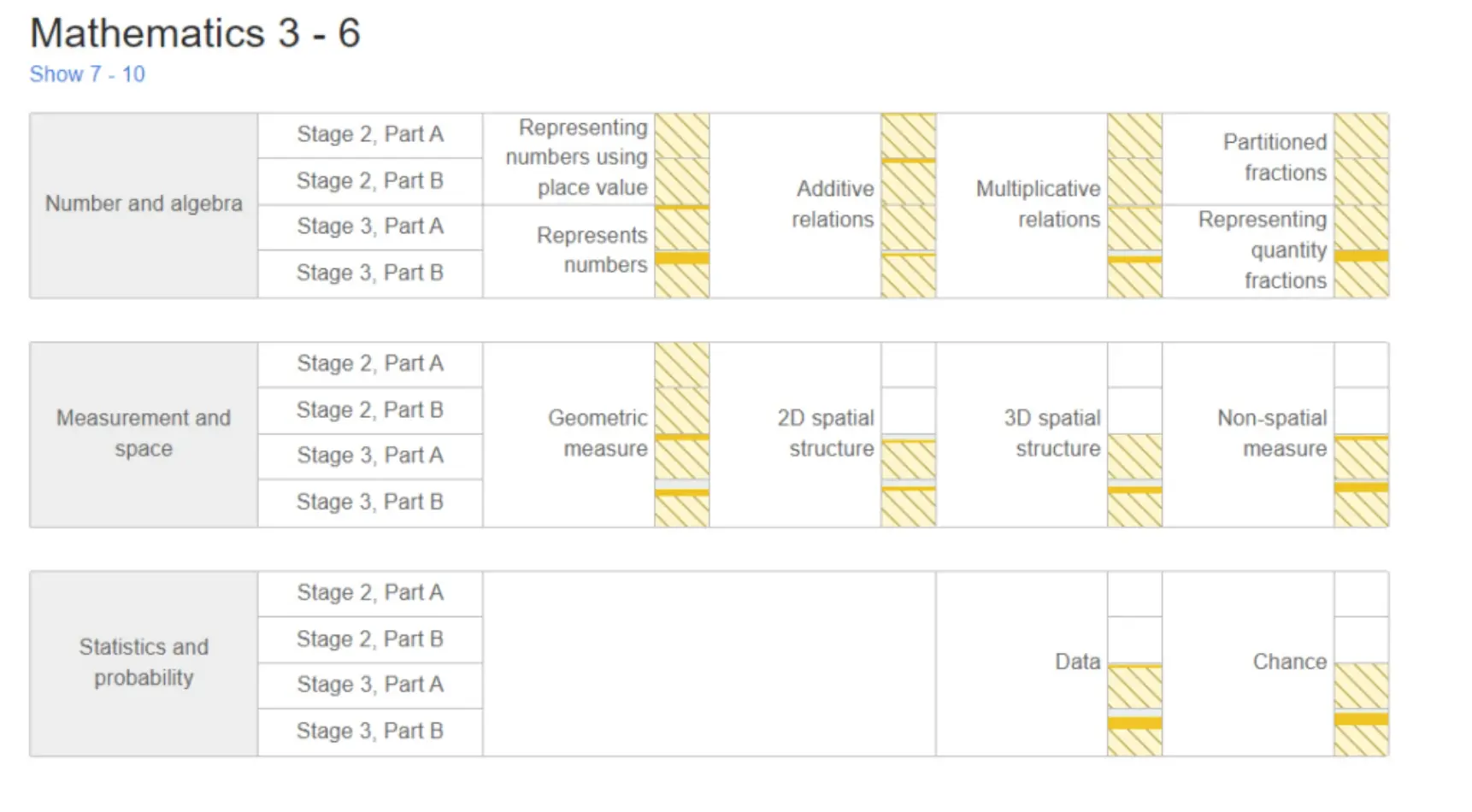
There is flexibility with how these form plans for any given year (NESA, 2023). However, one approach which could work in many contexts would be to create an “A” year and a “B” year, targeting Year 5 and Year 6 respectively.
Here is an example of how this would look:
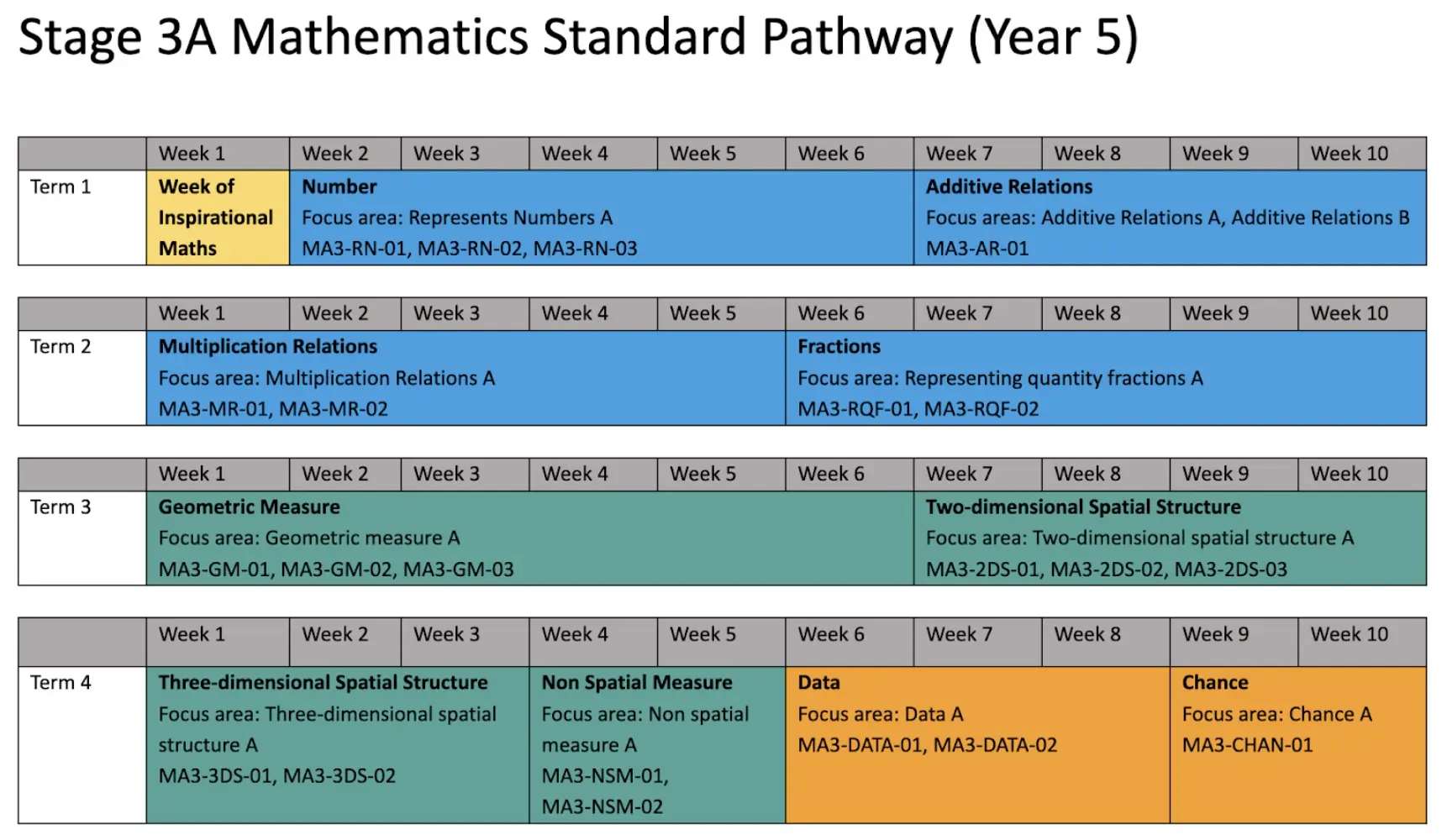
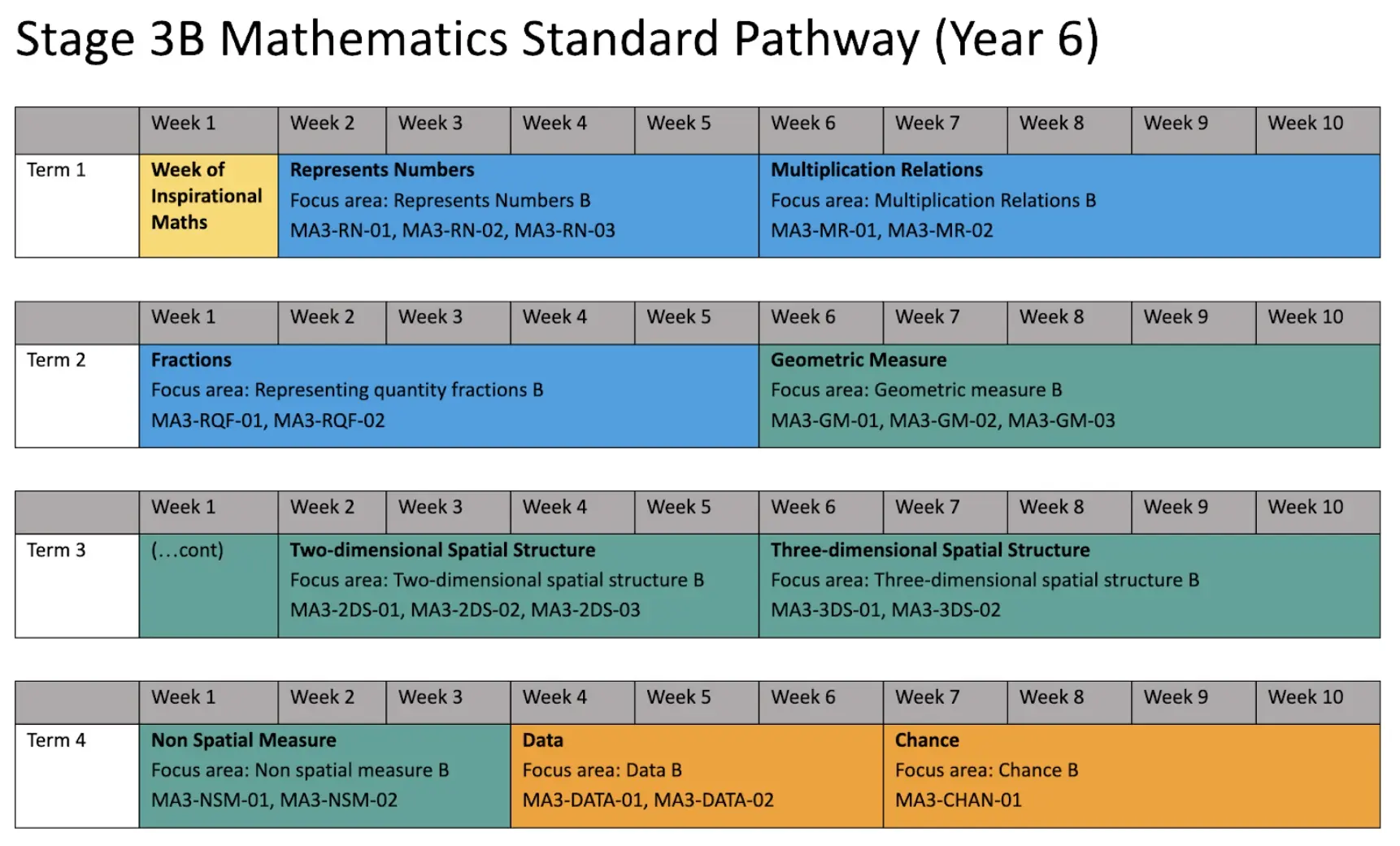
Want an example of a topic in full?
Download a free example, providing full Scope and Sequence and Topic documentation, for Year 5 and Year 6:
Stage 4 (Years 7-8)
Stage 4 contains 16 distinct Focus Areas:
- Computation with integers
- Fractions, decimals and percentages
- Ratios and rates
- Algebraic techniques
- Indices
- Equations
- Linear relationships
- Length
- Right-angled triangles
- Area
- Volume
- Angle relationships
- Properties of geometrical figures
- Data classification and visualisation
- Data analysis
- Probability
These are grouped into 9 “Broad Outcome Groups”. For example, the Focus Area “Volume” sits within the Broad Outcome Group “Length, area and volume”. These Broad Outcome Groups span Stages 4 and 5. Each Broad Outcome Group sits within a single Strand: Number and algebra; Measurement and space; or Statistics and Probability.
This can be visualised as follows:
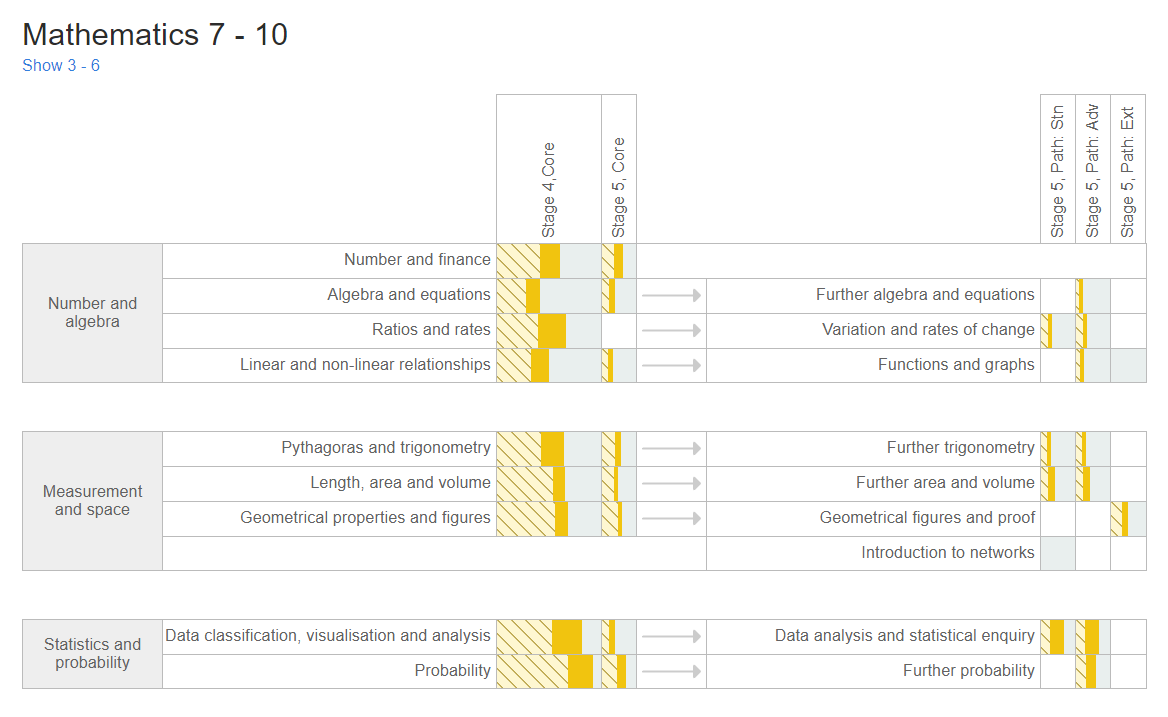
There is flexibility with how these 16 Focus Areas can form distinct sets for Years 7 and 8, including the option of some overlap or repetition (NESA, 2023).
Here is an example of how this could look:
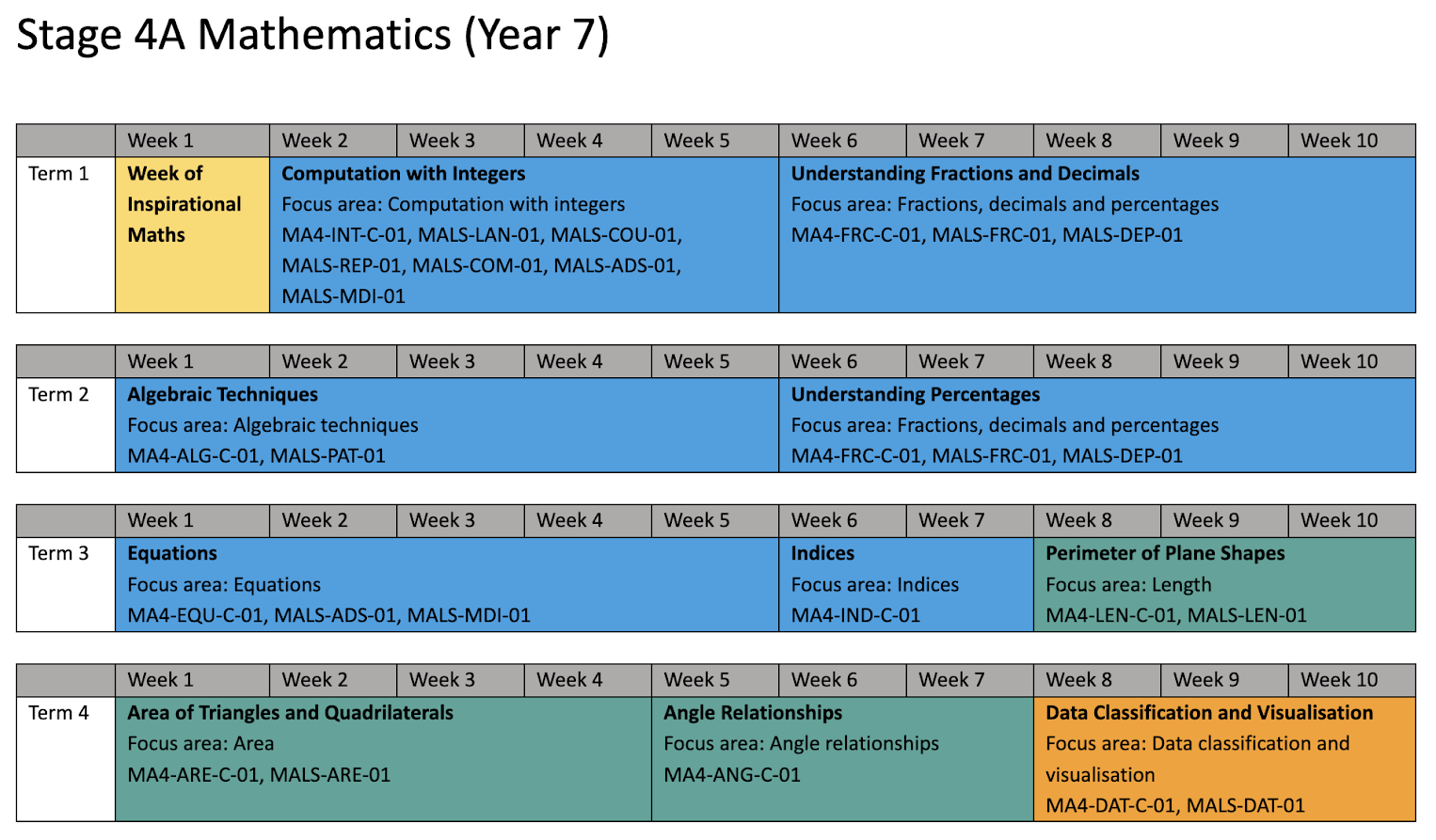

Want an example of a topic in full?
Here is a full example, providing full Scope and Sequence and Topic documentation.
Stage 5 (Years 9-10)
Stage 5 contains a whopping 41 Focus Areas.
There is no expectation that a given course contains all of these. Instead, they act as a sort of “menu” we can pick from to create different parallel “Streams” in Year 9 and 10, to prepare students for specific HSC subjects.
Some Focus Areas are referred to as “Core” in the Syllabus. This means that all Year 9/10 Streams should include them.
There are 18 Core Focus Areas:
- Financial mathematics A
- Financial mathematics B
- Linear relationships A
- Linear relationships B
- Non-linear relationships A
- Non-linear relationships B
- Numbers of any magnitude
- Trigonometry A
- Trigonometry B
- Area and surface area A
- Volume A
- Properties of geometrical figures
- Data analysis A
- Data analysis B
- Probability A
- Algebraic techniques A
- Indices A
- Equations A
Core Focus Areas are grouped into 9 “Broad Outcome Groups”. For example, the Focus Area “Volume A” sits within the Broad Outcome Group “Length, area and volume”. These Broad Outcome Groups span Stages 4 and 5. Each Broad Outcome Group sits within a single Strand: Number and algebra; Measurement and space; or Statistics and Probability.
This can be visualised as follows:

The remaining 23 Focus Areas we are able to mix and match to form our Year 9 and 10 Streams.
- Such Focus Areas are referred to as “Paths” in the Syllabus, and their names end with “(Path)”. For example, “Trigonometry C (Path)”
- Path Focus Areas can be grouped into the specific HSC subjects they help students prepare for. This can be done by examining the Outcome associated with each Focus Area. At the end of the Outcome’s description text can be found a key: “Stn”, “Adv” or “Ext” for Mathematics Standard, Mathematics Advanced, and Mathematics Extension, respectively.
- Path Focus Areas are also grouped into 9 Broad Outcome Groups, as pictured above. Note that Core Focus Areas and Path Focus Areas sit in separate Broad Outcome Groups to one another. Each of these Broad Outcome Groups still sits within a single Strand: Number and algebra; Measurement and space; or Statistics and probability.
Mathematics Standard has 6 Path Focus Areas:
- Trigonometry C (Path)*
- Area and surface area B (Path)*
- Volume B (Path)*
- Data analysis C (Path)*
- Variation and rates of change A (Path)*
- Introduction to networks (Path)
*These five Focus Areas are tagged with both Stn and Adv in the Syllabus. They are the only ones which overlap.
Mathematics Advanced has 18 Path Focus Areas:
- Linear relationships C (Path)
- Non-linear relationships C (Path)
- Trigonometry C (Path)*
- Trigonometry D (Path)
- Area and surface area B (Path)*
- Volume B (Path)*
- Data analysis C (Path)*
- Probability B (Path)
- Variation and rates of change A (Path)*
- Variation and rates of change B (Path)
- Algebraic techniques B (Path)
- Algebraic techniques C (Path)
- Indices B (Path)
- Indices C (Path)
- Equations B (Path)
- Equations C (Path)
- Logarithms (Path)
- Functions and other graphs (Path)
*These five Focus Areas are tagged with both Stn and Adv in the Syllabus. They are the only ones which overlap.
Mathematics Extension has 4 Path Focus Areas:
- Properties of geometrical figures B (Path)
- Properties of geometrical figures C (Path)
- Polynomials (Path)
- Circle geometry (Path)
Using these Focus Areas, we can form different Streams of Year 9 and 10 maths to prepare students for specific HSC subjects – by starting with the Core Focus Areas, and adding appropriate Path Focus Areas to each stream. There are many ways to do this (NESA, 2023).
However, one sensible approach for many contexts is to have three streams:
- Standard Pathway
- Standard/Advanced Pathway
- Advanced/Extension Pathway
Here is an example of how this could look for Year 9:
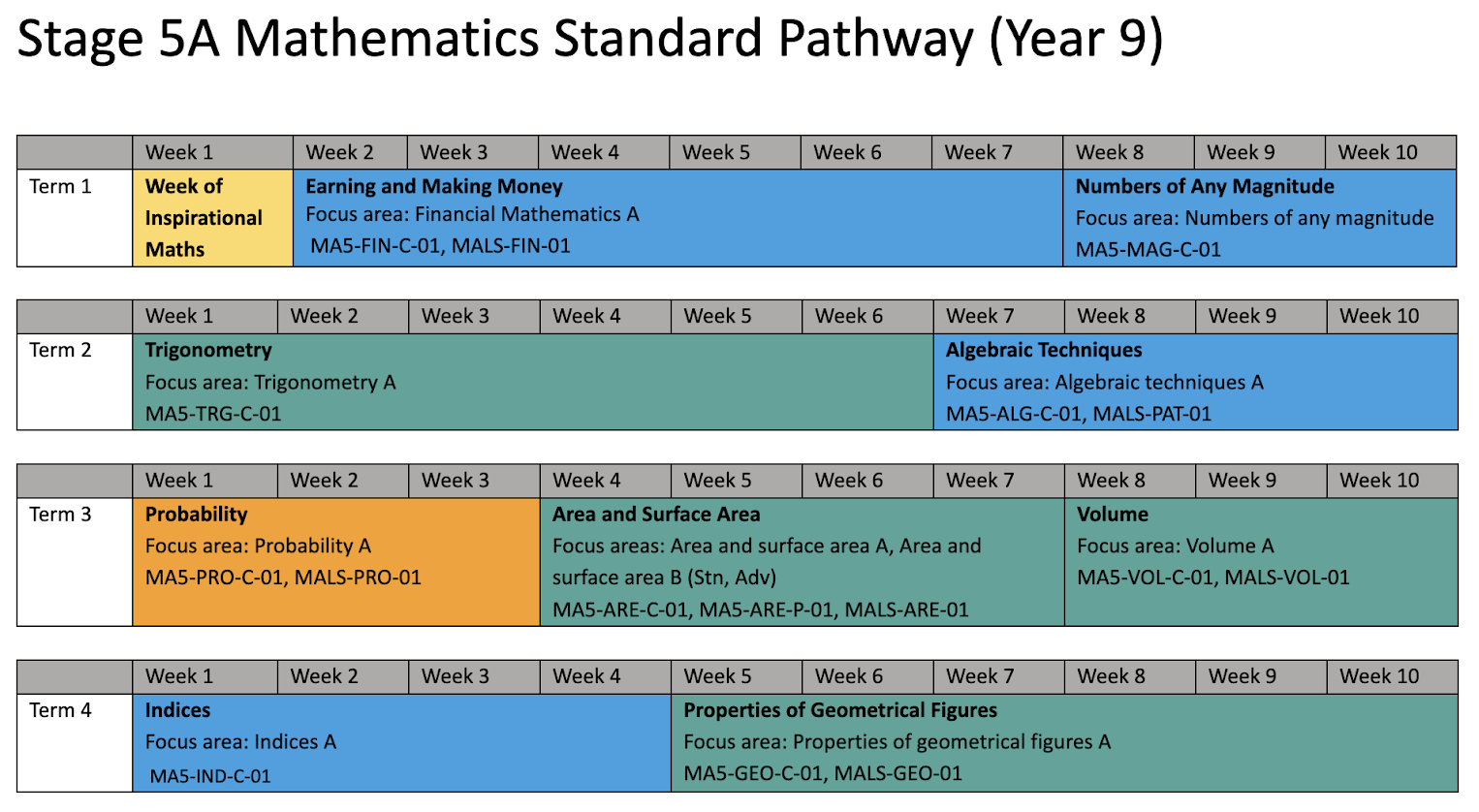
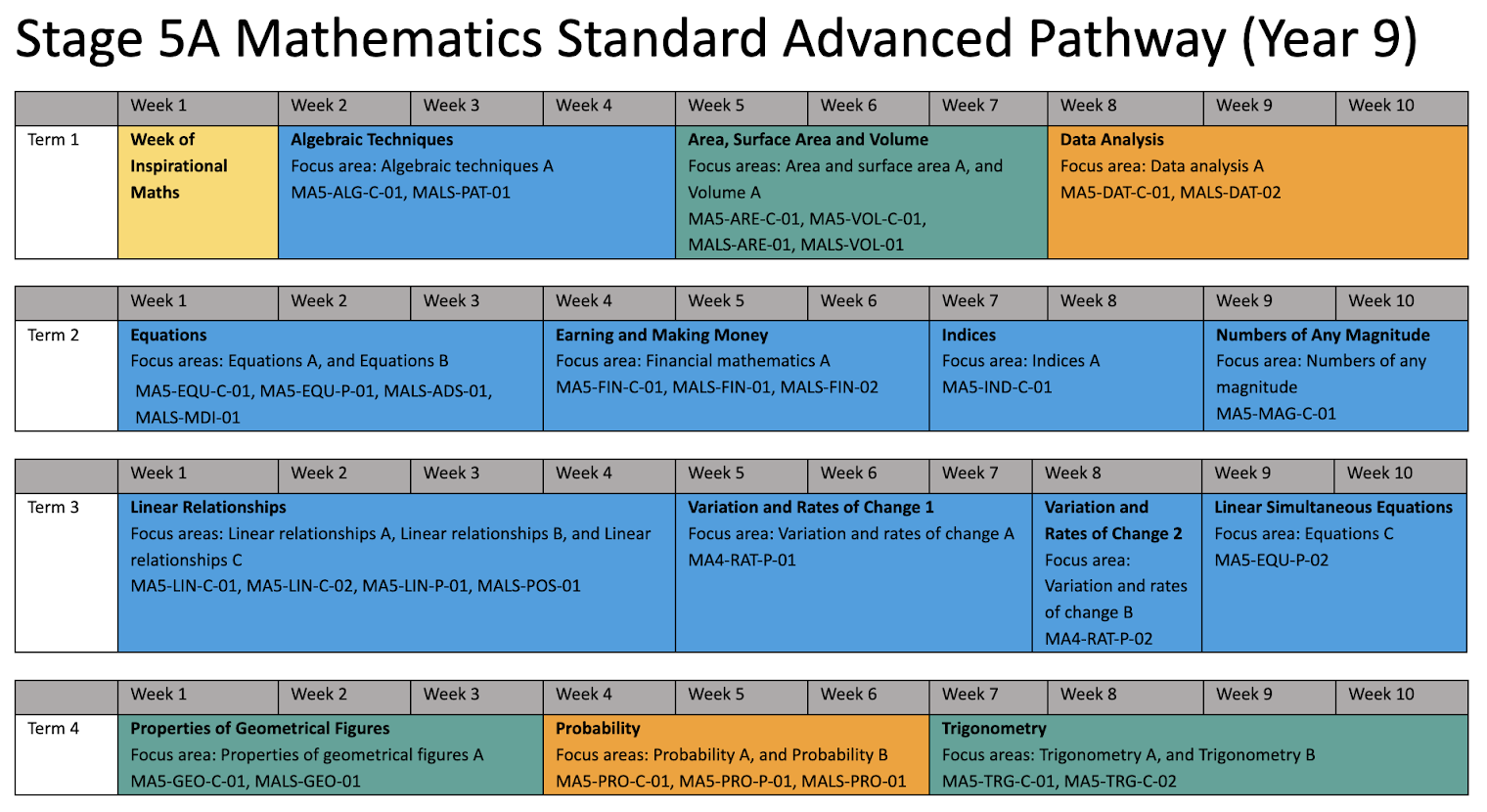
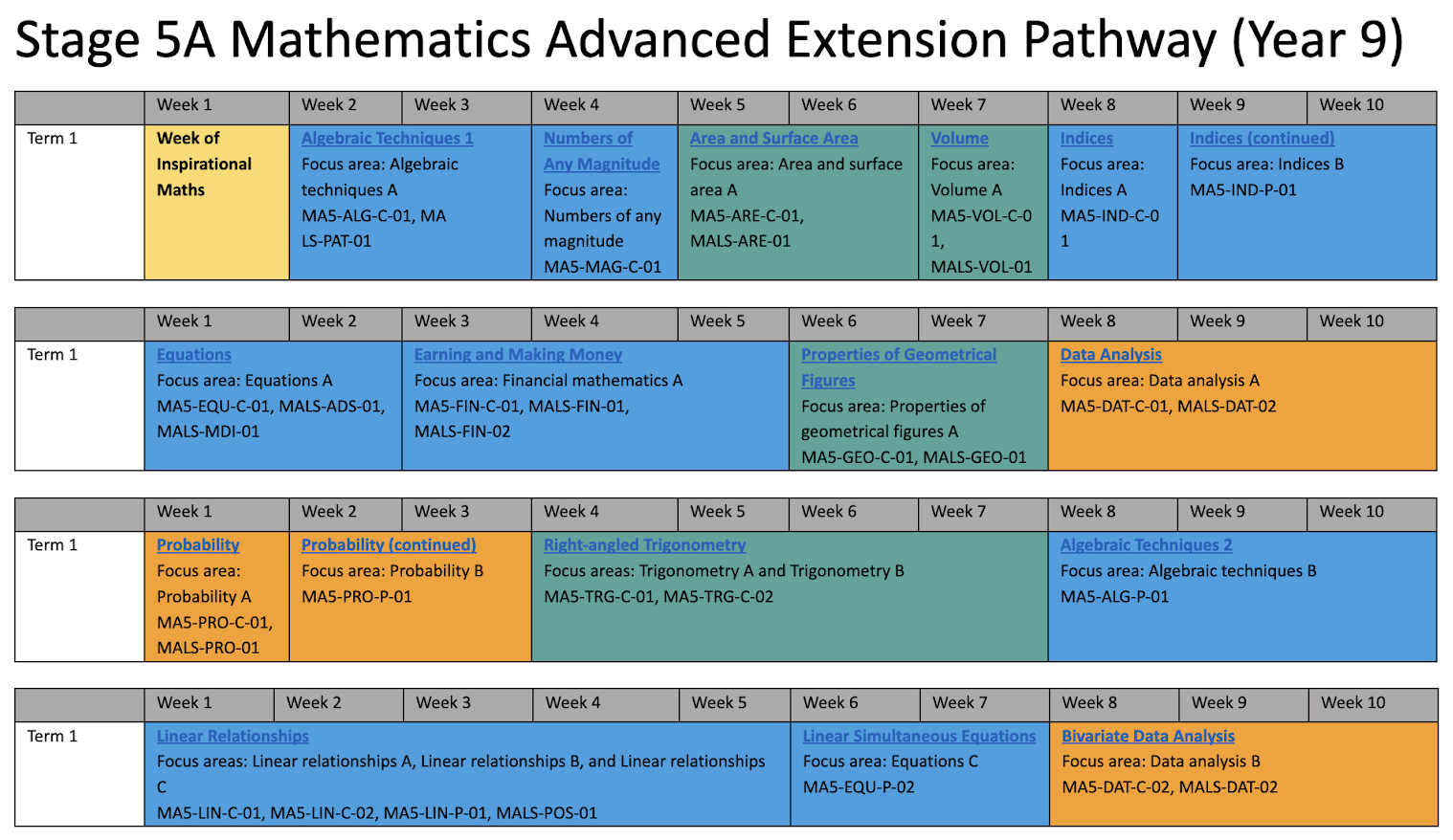
Want an example of a topic in full?
Here is a full example, providing full Scope and Sequence and Topic documentation.
Here is a matching example of how this could look for Year 10:
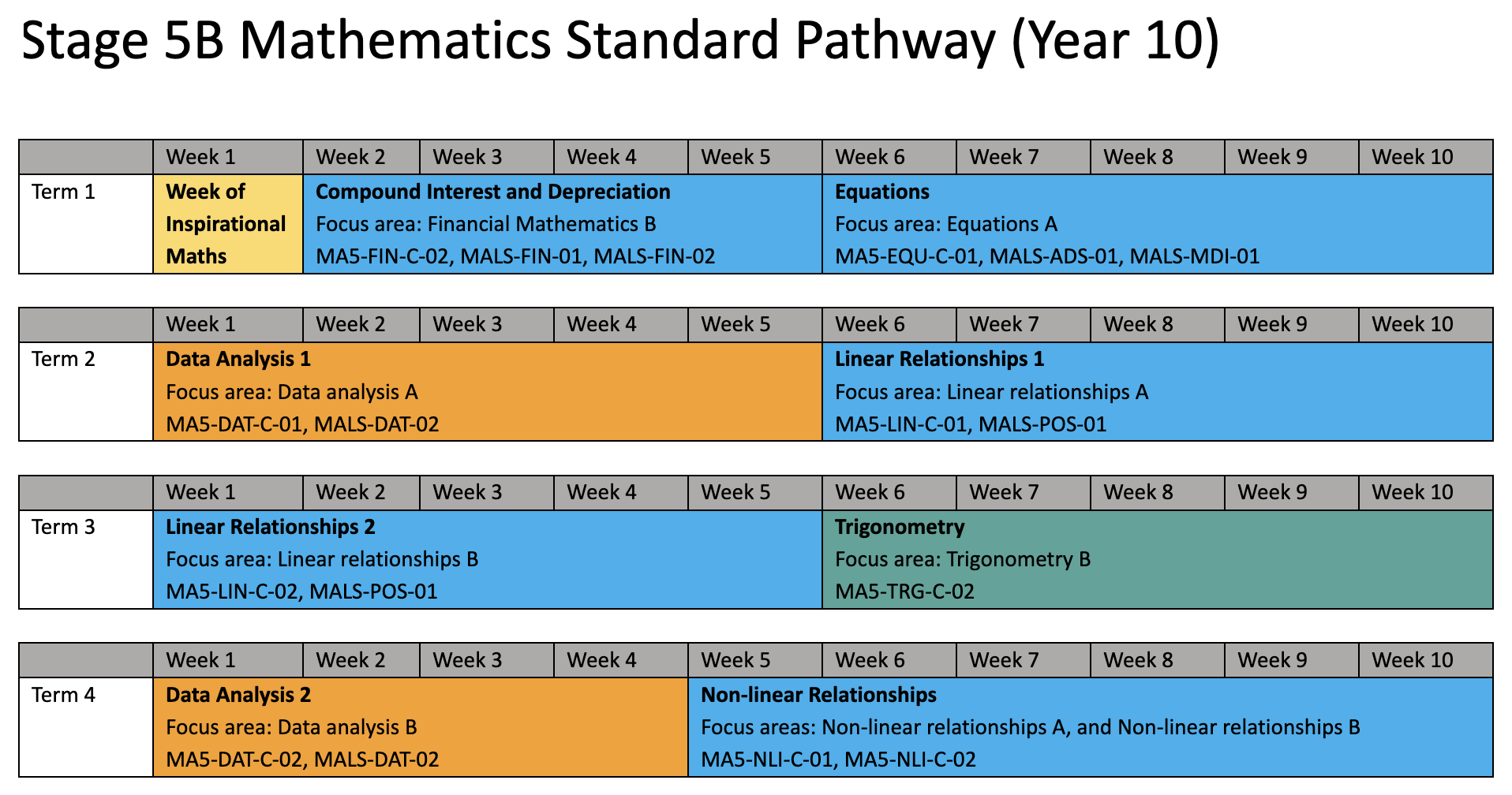
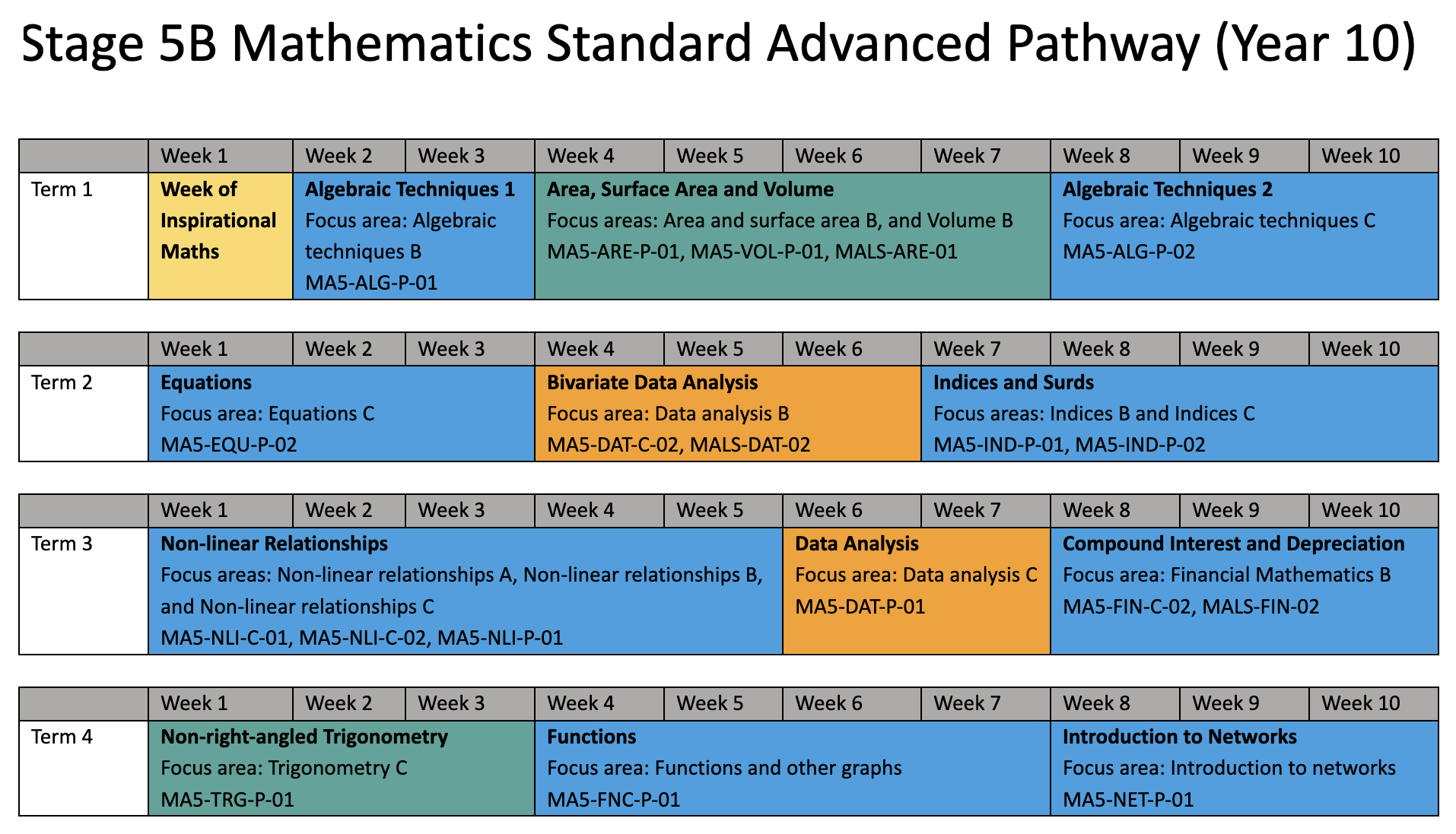
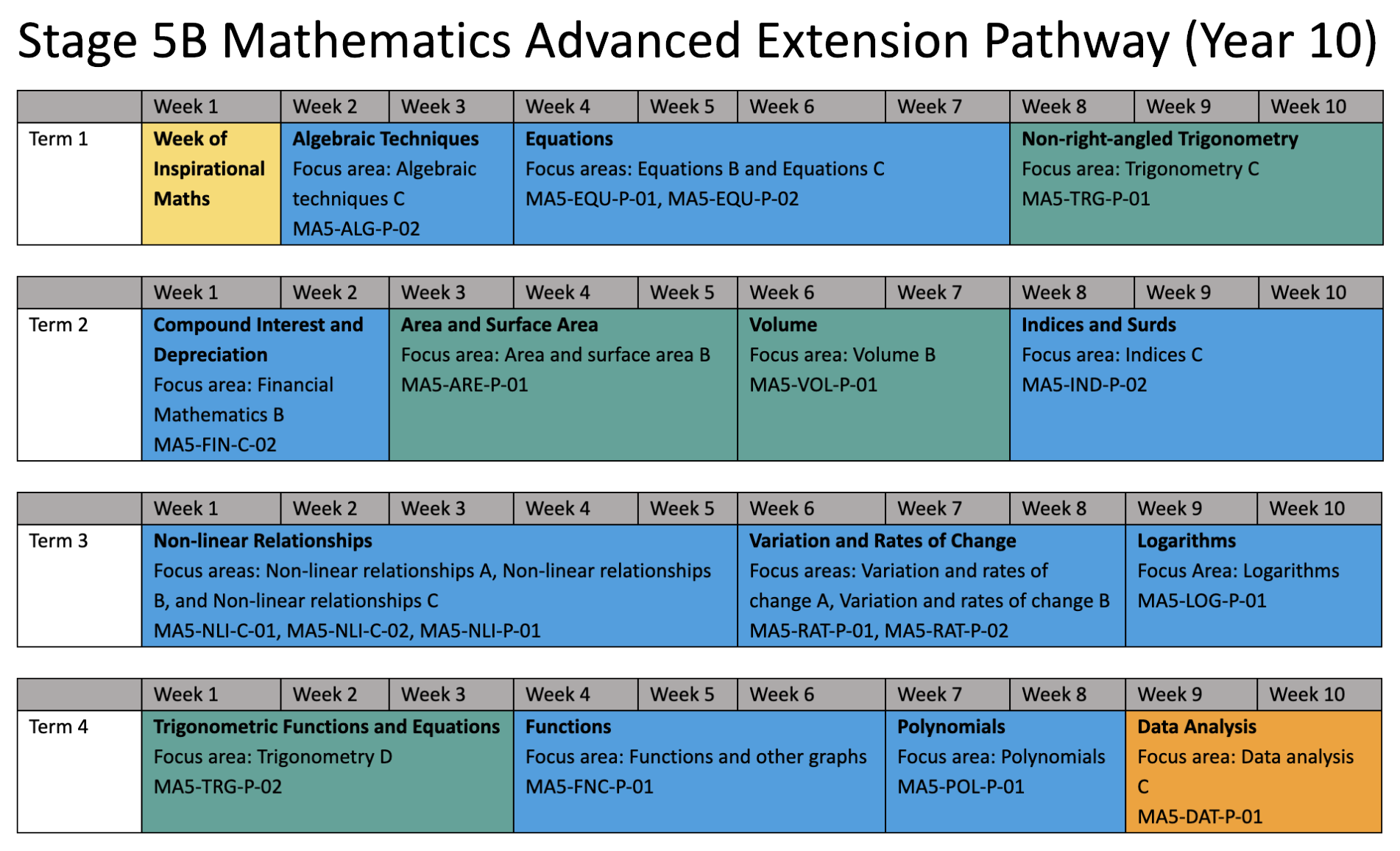
Want an example of a topic in full?
Here is a full example, providing full Scope and Sequence and Topic documentation.
Get in touch
Talk to us about how we can help your school transition to the new curriculum
Part 4. Bringing the Structure Together
What does it look like in a holistic way?
Working Mathematically
There is now a much simpler approach to Working Mathematically. There is a single Working Mathematically Outcome which spans the entirety of the K-10 Mathematics Syllabus, across all Stages and all Content:
“MAO-WM-01 develops understanding and fluency in mathematics through exploring and connecting mathematical concepts, choosing and applying mathematical techniques to solve problems, and communicating their thinking and reasoning coherently and clearly” (NESA 2023)
Mathematical Outcomes
Each Stage contains a set of Mathematical Outcomes. For example, Stage 5 contains the Outcome:
“MA5-FIN-C-01 solves financial problems involving simple interest, earning money and spending money” (NESA, 2023)
These Outcomes line up closely with the Focus Areas, which are what contain the actual content. There is often a one-to-one relationship between an Outcome and a Focus Area, but not always. Sometimes one Focus Area contains more than one Outcome, and sometimes the same Outcome maps to multiple Focus Areas.
We will see how to incorporate Outcomes into Topic Planning in an example below.
Life Skills Outcomes
Each Stage contains a set of mathematics Life Skills Outcomes. For example, Stage 5 contains the Life Skills Outcome:
“MA5-FIN-C-01 solves financial problems involving simple interest, earning money and spending money” (NESA 2023)
These Outcomes line up closely with the Focus Areas, which are what contain the actual content. There is often a one-to-one relationship between an Outcome and a Focus Area, but not always. Sometimes one Focus Area contains more than one Outcome, and sometimes the same Outcome maps to multiple Focus Areas.
We will see how to incorporate Outcomes into Topic Planning in an example below:
What does your planning look like in practice?
Topic Planning Example:
Here is an example of how a Topic could be planned, within a broader Scope and Sequence, tying this all together:
Step 1: Choose a name and duration for the topic.
We could create a topic called “Earning and Making Money” for Year 9 students, lasting 6 weeks.
Step 2: Choose at least one “Focus Area” for the topic, selected from the “Content” page on the Syllabus webpage.
We could select the Stage 5 Focus Area “Financial Mathematics A”.
Step 3: Record the mathematical “Outcomes” which align to that Focus Area. There is usually exactly one Outcome per Focus Area, and it shows on the left-hand side on the same.
We see that “Financial Mathematics A” lists the mathematical Outcome:
MA5-FIN-C-01 solves financial problems involving simple interest, earning money and spending money
Step 4: Record the “Life Skills Outcomes” which align to that Focus Area. Tick the “View Life Skills” box, and it will show on the left-hand side on the same Syllabus webpage.
We see that “Financial Mathematics A” lists the Life Skills Outcome:
MALS-FIN-01 demonstrates knowledge of money in everyday contexts
Step 5: Record the “Content” which aligns to that Focus Area. With “View Life Skills” unticked, this shows on the right-hand side of the same Syllabus webpage.
We see that “Financial Mathematics A” lists 12 dot-points of content. The first is: Solve problems involving wages given an hourly rate of pay including penalty rates for overtime, weekends and public holidays.
Step 6: Create and document a plan which allows all students to grow along a continuum, using the topic content as a focus. Students should all move closer to meeting those Outcomes, and go beyond if possible. This includes:
- Relevant resources ready to go which span multiple stages to meet all students’ needs;
- A specific plan for how data will be gathered to pinpoint student needs; and
- A practical approach for deploying those resources to meet those pinpointed needs.
Want an example of a topic in full?
Download a free sample Topic Plan: Earning & Making Money.
Need more help?
We’re here to answer your questions! Complete the form to find out more about how Maths Pathway can help you and your school.
Fill in the form to get start
Find out how your school can try Maths Pathway free this year
Are you from a Maths Pathway school? Contact our support team here [email protected]